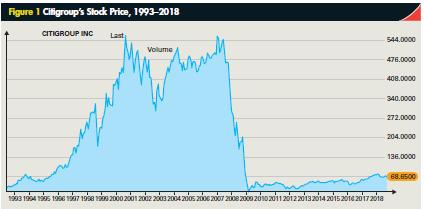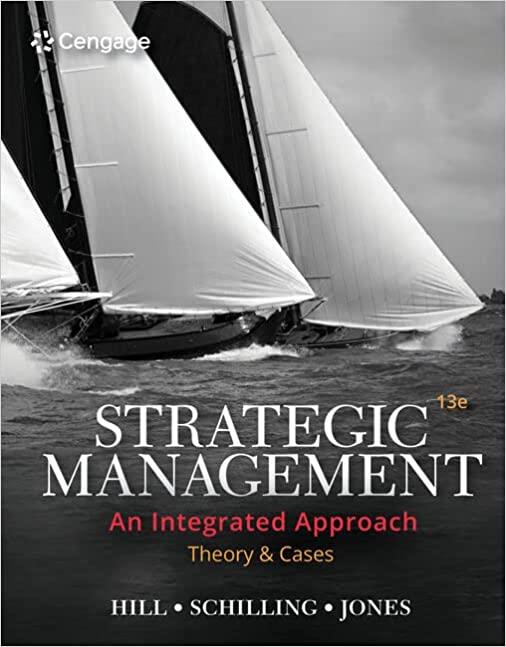In 2018, Citigroup was a $71.4-billion, diversified, financial services firm known around the world. However, its history
Question:
In 2018, Citigroup was a $71.4-billion, diversified, financial services firm known around the world. However, its history had not always been smooth. From the late 1990s through 2010, the company’s diversification moves, and its role in the mortgage crisis, combined to bring the company to its knees, raising fears that the venerable bank—one of the oldest and largest in the United States—would not survive.
Citigroup traces its history all the way back to 1812, when it was formed by a group of merchants in response to the abolishment of the First Bank of the United States (the First Bank’s charter had been permitted to lapse due to Thomas Jefferson’s arguments about the dangers of centralized control of the economy). The merchants, led by Alexander Hamilton, created the City Bank of New York in 1812, which they hoped would be large enough to replicate the scale advantages that had been offered by the First Bank. The bank played key roles in the rise of the United States as a global power, including lending money to support the purchasing of armaments for the War of 1812, financing the Union war effort in the mid-1800s, and later pioneering foreign-exchange trading, which helped to bring the United States to the world stage in the early 1900s. By 1929, it was the largest commercial bank in the world.
The bank’s capital resources and its trusted brand name enabled it to successfully diversify into a range of consumer banking services. The highly innovative company was, for example, the first to introduce savings accounts with compound interest, unsecured personal loans, checking accounts, and 24-hour ATMs, among other things. However, its business remained almost entirely within traditional, retail-banking services. That would soon change with the rise of a new concept: the “financial supermarket.”
During the 1990s, there was much buzz in the financial industry about the value of having a wide range of financial services within the same bank. Why have your savings account in New Jersey, your stock broker in California, and your insurance agent in Maryland, when you could have them all under one roof? Merging such services would enable numerous “cross-selling” opportunities: Each company’s customer bases could be more fully leveraged by promoting other financial products to them. Furthermore, cost savings might be realized by consolidating operations such as (including co-CEOs Weill and Reed) that some people compared Citi to Noah’s Ark. According to Meredith Whitney, a banking analyst who was an early critic of Citi’s megabank model, Citi had become “a gobbledygook of companies that were never integrated . . .
The businesses didn’t communicate with each other.
There were dozens of technology systems and dozens of financial ledgers.”
To boost earnings, Citi began investing in subprime loans, the risk of which was camouflaged by bundling the loans into mortgage-backed securities known as collateralized debt obligations (CDOs). Trouble began brewing before even Citi knew the scale of risk it had undertaken. Loose lending policies had resulted in a large number of poor-quality mortgages, the vast majority of which were adjustable-rate mortgages (i.e., the initial rate was very low but would increase over time).
This combined with a steep decline in housing prices that made it next to impossible for homebuyers to refinance their mortgages as their interest rates climbed—
their homes were now worth less than what they owed.
Delinquencies and foreclosures soared, meaning that banks holding those mortgages had assets of rapidly declining value. A lawsuit by Citi’s shareholders in 2006 accused the company of using a “CDO-related quasi-
Ponzi scheme” to falsely give the appearance that it had a healthy asset base and to conceal the true risks the company was facing, but even Citi’s CEO at the time, Charles O. Prince III, did not know how much the

company had invested in mortgage-related assets. Prince found out at a September 2007 meeting that the company had $43 billion in mortgage related assets, but was assured by Thomas Maheras (who oversaw trading at the bank) that everything was fine. Soon, the company was posting billions in losses, and its stock price fell to the lowest it had been in a decade (see Figure 1).
To Lynn Turner, a former chief accountant with the Securities and Exchange Commission, Citi’s crisis was no surprise. He pointed out that Citi was too large, did not have the right controls, and lacked sufficient accountability for individuals undertaking risks on the company’s behalf, making such problems inevitable.
The amalgamation of businesses had created conflicts of interest, and Citi’s managers lacked the ability to accurately gauge the risk of the exotic financial instruments that were proliferating. As the true scope of the problem was revealed, Citi found itself in very dire circumstances.
The losses from writing down its mortgage assets threatened to destroy the entire company, bringing down even its profitable lines of business.
While the U.S. government kept the bank from failing with a $45-billion bailout (out of fear that Citi’s failure would cause an even greater economic collapse—giving rise to the phrase “too big to fail”), Citigroup began reducing its workforce and selling off everything it could, dismantling its financial supermarket.
Over the next 2 years, it slashed over 80,000 jobs and sold Smith Barney, Phibro (its commoditiestrading unit), Diner’s Club (a credit card), its Japanese brokerage operations, Primerica, and more. Furthermore, to raise capital it sold 5% of its equity to the Abu Dhabi Investment authority for $7.5 billion, and then raised another $12 billion by selling shares to a group of investors that included Prince Alwaleed Bin Talal of Saudi Arabia in 2008. It also restructured into two operating units: Citicorp for retail and institutional client business, and Citi Holdings for its brokerage and asset management. This reorganization would help isolate Citi’s banking operations from the riskier assets it wished to sell.
In 2010, Citigroup finally returned to profitability.
It repaid its U.S. government loans, and its managers and the investment community breathed a sigh of relief, optimistic that the worst was over. In 2014, Citi posted $76.9 billion in revenues and $7.3 billion in net income. Today, roughly 50% of its revenues come from its consumer businesses (retail banking, credit cards, mortgages, and commercial banking for small-to-medium businesses); just over 40% comes from its Institutional Clients group (which provides investment and banking services for corporations, governments, institutions, and ultra-high-net-worth individuals); and Citi Holdings accounts for just under 10% of revenues.
The saga of Citi seriously undermined the investment community’s faith in the financial supermarket model, although in the wake of the mortgage crisis it was difficult to assess how much had been gained and lost through the diversification of the firm. One thing was clear, however: Having a very large, complex organization had made it more difficult to provide sufficient, and effective, oversight within the firm. This, in turn, allowed problems to grow very threatening before being detected. Citi’s managers knew they would have to think much more carefully about their business choices in the future, and about how to manage the interdependencies between those businesses.
Questions
1. What advantages did Citigroup’s managers think would result from creating a “financial supermarket”?
2. Why didn’t the “financial supermarket” concept pay off the way Citi’s managers had anticipated?
3. Why do you think it was so hard to integrate the different companies that were merged?
4. What are some challenges involved with managing a very large, diverse, financial services company?
Step by Step Answer:

Strategic Management Theory And Cases An Integrated Approach
ISBN: 9780357033845
13th Edition
Authors: Charles W. L. Hill, Melissa A. Schilling, Gareth R. Jones





